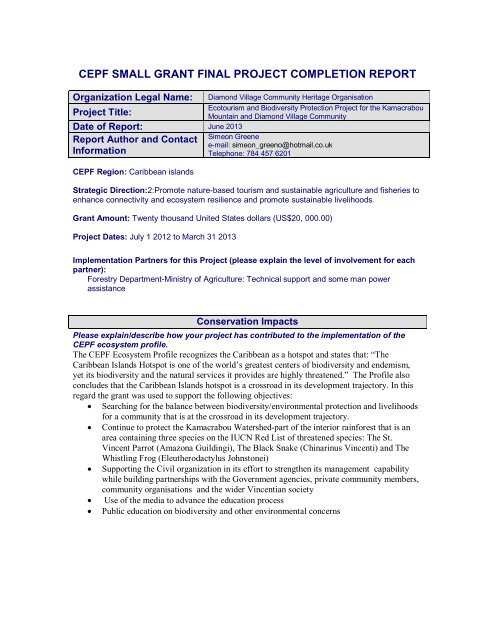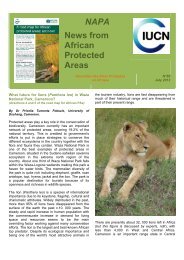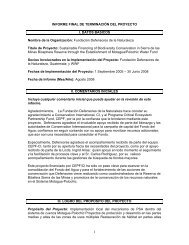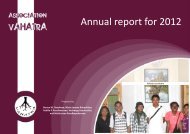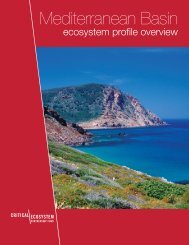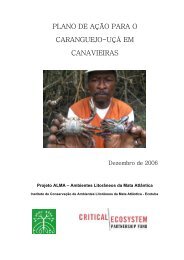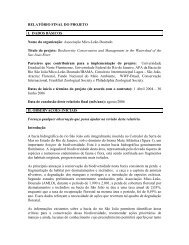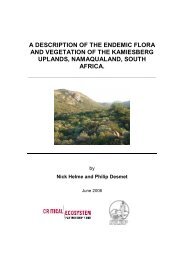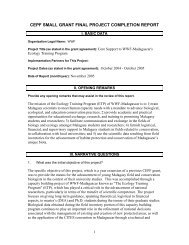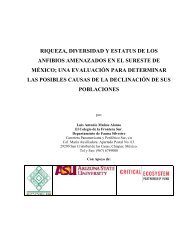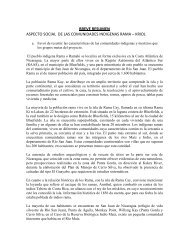final project completion report - Critical Ecosystem Partnership Fund
final project completion report - Critical Ecosystem Partnership Fund
final project completion report - Critical Ecosystem Partnership Fund
Create successful ePaper yourself
Turn your PDF publications into a flip-book with our unique Google optimized e-Paper software.
CEPF SMALL GRANT FINAL PROJECT COMPLETION REPORT<br />
Organization Legal Name:<br />
Project Title:<br />
Date of Report: June 2013<br />
Report Author and Contact<br />
Information<br />
CEPF Region: Caribbean islands<br />
Diamond Village Community Heritage Organisation<br />
Ecotourism and Biodiversity Protection Project for the Kamacrabou<br />
Mountain and Diamond Village Community<br />
Simeon Greene<br />
e-mail: simeon_greeno@hotmail.co.uk<br />
Telephone: 784 457 6201<br />
Strategic Direction:2:Promote nature-based tourism and sustainable agriculture and fisheries to<br />
enhance connectivity and ecosystem resilience and promote sustainable livelihoods.<br />
Grant Amount: Twenty thousand United States dollars (US$20, 000.00)<br />
Project Dates: July 1 2012 to March 31 2013<br />
Implementation Partners for this Project (please explain the level of involvement for each<br />
partner):<br />
Forestry Department-Ministry of Agriculture: Technical support and some man power<br />
assistance<br />
Conservation Impacts<br />
Please explain/describe how your <strong>project</strong> has contributed to the implementation of the<br />
CEPF ecosystem profile.<br />
The CEPF <strong>Ecosystem</strong> Profile recognizes the Caribbean as a hotspot and states that: “The<br />
Caribbean Islands Hotspot is one of the world’s greatest centers of biodiversity and endemism,<br />
yet its biodiversity and the natural services it provides are highly threatened.” The Profile also<br />
concludes that the Caribbean Islands hotspot is a crossroad in its development trajectory. In this<br />
regard the grant was used to support the following objectives:<br />
• Searching for the balance between biodiversity/environmental protection and livelihoods<br />
for a community that is at the crossroad in its development trajectory.<br />
• Continue to protect the Kamacrabou Watershed-part of the interior rainforest that is an<br />
area containing three species on the IUCN Red List of threatened species: The St.<br />
Vincent Parrot (Amazona Guildingi), The Black Snake (Chinarinus Vincenti) and The<br />
Whistling Frog (Eleutherodactylus Johnstonei)<br />
• Supporting the Civil organization in its effort to strengthen its management capability<br />
while building partnerships with the Government agencies, private community members,<br />
community organisations and the wider Vincentian society<br />
• Use of the media to advance the education process<br />
• Public education on biodiversity and other environmental concerns
Please summarize the overall results/impact of your <strong>project</strong> against the expected results<br />
detailed in the approved proposal.<br />
Nu Summarised Expected Summarised Actual Results<br />
m. Results<br />
1 To attract visitors and tourists<br />
to the village through the<br />
demarcation of the Bubby<br />
Stone Trail as a nationally<br />
recognized nature trail.<br />
At the opening of the trail over 200 people attended and<br />
there was extensive media coverage. Please see photo<br />
documentation of the demarcation of Bubby Stone Trail<br />
in Appendix 1, newspaper articles on the opening of the<br />
trail in Appendix 2 and a brochure on the trail in<br />
Appendix 3. Since then we have seen several groups<br />
from outside the district visit the trail as well as many<br />
inquiries about larger group tours. Through the media<br />
the Bubby Stone Trail has been recognized nationally<br />
as the most recent ecotourism site. The true potential of<br />
this <strong>project</strong> is still not completely known but the initial<br />
2 To ensure reforestation of<br />
traditional rainforest land by<br />
planting trees on 1 acre of land<br />
in the Kamacroubou<br />
Watershed.<br />
3 To enhance quality of life and<br />
conservation of the traditional<br />
forests by training 10<br />
community members in<br />
culinary arts.<br />
4 To ensure the protection of<br />
biologically diverse habitats by<br />
engaging the community in a<br />
public awareness campaign.<br />
results suggest that this trail has a bright future.<br />
Over one acre has been cleared and planted with forest<br />
trees and local wildings. We feel confident about the<br />
sustainability of this plot because the forestry<br />
department has taken on the responsibility to tend to<br />
these plants.<br />
These community members have been given the<br />
training to offer catering with local foods to incoming<br />
visitors. See photo documentation of the culinary arts<br />
training programme in Appendix 4 and palm card<br />
advertising their services in Appendix 5. With the trail<br />
becoming an area of livelihood for these community<br />
members as well as the farmers who grow the food it is<br />
incumbent that the community will want to continue the<br />
preservation of the trail and the surrounding forest, thus<br />
meeting our conservation objective.<br />
With the involvement of the Forestry Department and<br />
Central Water and Sewage Authority (CWSA) a<br />
workshop was provided for a cross section of the local<br />
community. Additionally, public awareness sessions<br />
were conducted within the village for all community<br />
members to attend. We also pledge to continue this<br />
process by engaging community members in<br />
community service <strong>project</strong>s to protect our local<br />
environment.<br />
Please provide the following information where relevant:<br />
Hectares Protected: The entire valley and spur under protection is about 6 hectares. Not all the<br />
work is as a result of this <strong>project</strong> under consideration; but this <strong>project</strong> has further contributed to<br />
the entire programme which started in 1998.<br />
Species Conserved: Apart from the forest species replanted, the three target fauna species are<br />
on the IUCN Red List of Threatened Species:<br />
1. St. Vincent Parrot (Amazona Guildingi)<br />
2. Black Snake (Chinorinus Vincenti)<br />
3. Whistling Frog (Eleutherodactylus Johnstonei)<br />
Corridors Created: None.
Describe the success or challenges of the <strong>project</strong> toward achieving its short-term and<br />
long-term impact objectives.<br />
No major obstacles were presented in the implementation of the small grant contract. The<br />
objectives that we set out to achieve for this <strong>project</strong> ultimately were successful. With the cooperation<br />
of the key stakeholders, the <strong>project</strong> has come to this concluding phase. The most<br />
pertinent challenge now is to sustain the effort and keep the public, private and civil organization<br />
partnership going. How do we manage the trail and not to let the area go beyond its carrying<br />
capacity? Already, this has become an area of concern. There is also the remnant of the original<br />
conflict between, farming and forestry. Some farmers who have since moved their cattle to private<br />
lands down-stream from the forest boundary still could pose a threat to the area, but the<br />
legislative framework is in place and should be used to stave off this challenge.<br />
Were there any unexpected impacts (positive or negative)?<br />
• Given the wide spread media coverage, the large attendance at the opening of the trail,<br />
and the frequent use of the trail subsequently, this has become a concern. The<br />
organization is soon to meet to deal with this unexpected early popularity of the trail.<br />
• As the trail provides an additonal livelihood opportunity for the community, conservation<br />
issues are seen with a greater importance. The community has now become more aware<br />
of the down-stream environmental issues such as beautification, biodiversity, the impact<br />
of littering and keeping the stream healthy and alive. More awareness efforts are planned<br />
by targeting partners such as the school, churches, Central Water and Sewerage<br />
Authority (CWSA) and other community organizations.<br />
• One of the Culinary Arts trainee is operating a restaurant and a few others continue to<br />
sell from trays in the community. This is one of the ancillary services that are connected<br />
to the culinary arts training which, as stated previously, livelihoods like this that are<br />
connected to the trail will also directly result in conservation of the trail.<br />
• Non-legal cultivators are taking notice given the frequency with which the area is being<br />
visited: where the trail is now located use to be a source for illegal cultivation of marijuana<br />
due to the infrequent visitation. Now, as a direct result of the demarcation of the trail and<br />
more outside visitors, this illegal cultivation has ceased.<br />
Lessons Learned<br />
Describe any lessons learned during the design and implementation of the <strong>project</strong>, as well<br />
as any related to organizational development and capacity building. Consider lessons that<br />
would inform <strong>project</strong>s designed or implemented by your organization or others, as well as<br />
lessons that might be considered by the global conservation community.<br />
• Small grants properly managed can have a huge community and national impact.<br />
Providing livelihood opportunities for over 24 members of the community was vital during<br />
this tough economic time.<br />
• Wide community embrace is already proving beneficial. Consult and educate the<br />
community always.<br />
• Building and maintaining the partnership between public, private and community<br />
organization is vital for success. Some of these <strong>project</strong>s could be quite technical in<br />
nature. Bringing on board the right mixture of skills was important for success.<br />
• Linking the <strong>project</strong> areas of intervention with previous <strong>project</strong> interventions improved<br />
impact. In the case of this <strong>project</strong>, the Forestry Division had already intervened in the<br />
<strong>project</strong> area in 1998 reforesting 5 acres of land previously cleared for farming and the<br />
Diamond Village Community Heritage Organisation, had implemented in 2011 “ The<br />
environmental Watershed Project for Sustainable Livelihood” funded by FAO. Also from a<br />
previous FAO funded <strong>project</strong>, 12 community members received training in tour-guiding.
Project Design Process: (aspects of the <strong>project</strong> design that contributed to its<br />
success/shortcomings)<br />
• As was stated above, the linkages with other previous interventions were important for<br />
the <strong>project</strong> design. This process has given the <strong>project</strong> a chance of being sustainable.<br />
• Flexibility within the guidelines-15% of <strong>project</strong> funds- was important, because as the<br />
implementation process got on the way, adjustments were necessary.<br />
• The way the two main components –culinary arts training and the demarcation of the<br />
trail-did not have to run concurrently did assist with the ease of implementation<br />
• In the <strong>project</strong> design, enough attention was not given to how the site would be managed<br />
Project Implementation: (aspects of the <strong>project</strong> execution that contributed to its<br />
success/shortcomings)<br />
• The ready availability of technical advice on the <strong>project</strong> site from the Forestry Division<br />
contributed to success.<br />
• Team-work and division of labour with team supervisors contributed to success.<br />
• While the latter half of 2012 would not have been good to build the trail because of the<br />
rain; it would have been good for the planting of the trees. The first quarter of 2013 was<br />
dry and tree growth would have been impaired. Some trees therefore may have to be<br />
replanted.<br />
Other lessons learned relevant to conservation community:<br />
• From observing some of the mistakes made by those who visit the trail-taking of samples<br />
and low level littering-the effort to educate the community and other visitors cannot<br />
cease.<br />
ADDITIONAL FUNDING<br />
Provide details of any additional donors who supported this <strong>project</strong> and any funding<br />
secured for the <strong>project</strong> as a result of the CEPF grant or success of the <strong>project</strong>.<br />
Donor Type of <strong>Fund</strong>ing* Amount Notes<br />
*Additional funding should be <strong>report</strong>ed using the following categories:<br />
A<br />
Project co-financing (Other donors contribute to the direct costs of this CEPF <strong>project</strong>)<br />
B<br />
C<br />
Grantee and Partner leveraging (Other donors contribute to your organization or a partner<br />
organization as a direct result of successes with this CEPF <strong>project</strong>.)<br />
Regional/Portfolio leveraging (Other donors make large investments in a region because<br />
of CEPF investment or successes related to this <strong>project</strong>.)
Sustainability/Replicability<br />
Summarize the success or challenge in achieving planned sustainability or replicability of <strong>project</strong><br />
components or results.<br />
• The challenge now, is to manage and maintain the trail with community involvement without a<br />
known source of funds for these operations. Do we find a way to implement user fees? The<br />
Forestry Division has to be central to strengthening that partnership with the community through the<br />
Heritage Organisation. The ground work has started to facilitate these discussion<br />
• How do we incorporate the training in culinary arts and previous training in Tour-guiding to build a<br />
sustainable model to achieve community livelihoods? In this regard, efforts are being made to have<br />
this new site placed on the list of sites to be visited by cruise ships tourists. For this to become a<br />
reality, the community has to be sold as a holistic cultural package: heritage sites, food, friendly<br />
people, clean environment and a bio diverse, Kamacrabou watershed from reef to mountain.<br />
• The encouraging fact is that the Forestry Division keeps a crew of at least 2 men in the watershed<br />
on a permanent basis.<br />
• The government has donated a site to be used as an office in which we plan to coordinate<br />
activities. We intend to use small entrance fees to maintain any costs associated with sustaining<br />
the trail. Furthermore, regular public community service <strong>project</strong>s will be coordinated to maintain the<br />
cleanliness of the trail and the community leading to this area.<br />
Summarize any unplanned sustainability or replicability achieved.<br />
Safeguard Policy Assessment<br />
Provide a summary of the implementation of any required action toward the environmental<br />
and social safeguard policies within the <strong>project</strong>.<br />
Additional Comments/Recommendations<br />
• To run the trail successfully there is need for the next phase of the development to take<br />
place: a comfort site at the beginning of the trail and the commissioning of other heritage<br />
sites within the community<br />
• Strengthening of the Diamond Village Heritage Community Organisation by<br />
commissioning an office and obtain a full-time employee. With the assistance of the<br />
Government, an old post office is in the process of being converted into an office and as<br />
a temporary measure, a member of the YES (Youth Empowerment Service) has been<br />
assigned.<br />
Information Sharing and CEPF Policy<br />
CEPF is committed to transparent operations and to helping civil society groups share<br />
experiences, lessons learned, and results. Final <strong>project</strong> <strong>completion</strong> <strong>report</strong>s are made available on<br />
our Web site, www.cepf.net, and publicized in our newsletter and other communications.<br />
Please include your full contact details below:<br />
Name: Simeon Greene<br />
Organization name: Diamond Village Community Heritage Organisation<br />
Mailing address: Colonarie Post Office; Post Code VC0250<br />
Tel:784 457 6201/ 784 492 3055
Fax:<br />
E-mail: simeon_greeno@hotmail.co.uk<br />
***If your grant has an end date other than JUNE 30, please<br />
complete the tables on the following pages***
Performance Tracking Report Addendum<br />
CEPF Global Targets<br />
(Enter Grant Term)<br />
Provide a numerical amount and brief description of the results achieved by your grant.<br />
Please respond to only those questions that are relevant to your <strong>project</strong>.<br />
Project Results<br />
1. Did your <strong>project</strong> strengthen<br />
management of a protected area<br />
guided by a sustainable<br />
management plan? Please indicate<br />
number of hectares improved.<br />
2. How many hectares of new<br />
and/or expanded protected areas<br />
did your <strong>project</strong> help establish<br />
through a legal declaration or<br />
community agreement?<br />
3. Did your <strong>project</strong> strengthen<br />
biodiversity conservation and/or<br />
natural resources management<br />
inside a key biodiversity area<br />
identified in the CEPF ecosystem<br />
profile? If so, please indicate how<br />
many hectares.<br />
4. Did your <strong>project</strong> effectively<br />
introduce or strengthen biodiversity<br />
conservation in management<br />
practices outside protected areas?<br />
If so, please indicate how many<br />
hectares.<br />
5. If your <strong>project</strong> promotes the<br />
sustainable use of natural<br />
resources, how many local<br />
communities accrued tangible<br />
socioeconomic benefits? Please<br />
complete Table 1below.<br />
Is this<br />
question<br />
relevant?<br />
no<br />
no<br />
yes 6<br />
no<br />
If yes,<br />
provide your<br />
numerical<br />
response for<br />
results<br />
achieved<br />
during the<br />
annual<br />
period.<br />
Provide<br />
your<br />
numerical<br />
response<br />
for <strong>project</strong><br />
from<br />
inception<br />
of CEPF<br />
support to<br />
date.<br />
Describe the principal results<br />
achieved from<br />
July 1, 2012 to June 30, 2013.<br />
(Attach annexes if necessary)<br />
The <strong>project</strong> has so far been making a national<br />
impact given the widespread media coverage..<br />
Since the entire rainforest of SVG is a key<br />
biodiversity area, the <strong>project</strong> must have impacted<br />
on other communities and the nation as a whole.<br />
yes 1 Socioeconomic benefits in Diamond Village<br />
If you answered yes to question 5, please complete the following table.
Table 1. Socioeconomic Benefits to Target Communities<br />
Please complete this table if your <strong>project</strong> provided concrete socioeconomic benefits to local communities. List the name of each community in column one. In the subsequent columns<br />
under Community Characteristics and Nature of Socioeconomic Benefit, place an X in all relevant boxes. In the bottom row, provide the totals of the Xs for each column.<br />
Community Characteristics<br />
Nature of Socioeconomic Benefit<br />
Name of Community<br />
Small landowners<br />
Subsistence economy<br />
Indigenous/ ethnic peoples<br />
Pastoralists/nomadic peoples<br />
Recent migrants<br />
Urban communities<br />
Communities falling below the<br />
poverty rate<br />
Other<br />
Increased Income due to:<br />
Adoption of sustainable<br />
natural resources<br />
management practices<br />
Increased food security due<br />
to the adoption of sustainable<br />
fishing, hunting, or<br />
agricultural practices<br />
Diamond Village x x x x x<br />
Ecotourism revenues<br />
Park management<br />
activities<br />
Payment for<br />
environmental services<br />
More secure access to water<br />
resources<br />
Improved tenure in land or other<br />
natural resource due to titling,<br />
reduction of colonization, etc.<br />
Reduced risk of natural<br />
disasters (fires, landslides,<br />
flooding, etc)<br />
More secure sources of<br />
energy<br />
Increased access to public<br />
services, such as education,<br />
health, or credit<br />
Improved use of traditional<br />
knowledge for environmental<br />
management<br />
More participatory decisionmaking<br />
due to strengthened<br />
civil society and governance.<br />
Other<br />
Total<br />
If you marked “Other”, please provide detail on the nature of the Community Characteristic and Socioeconomic Benefit:
Diamond Village Community Heritage Organisation<br />
Photo Documentation<br />
Bubby Stone Trail Demarcation<br />
Project for the Kamacrabou Mountain and the Diamond Village Community<br />
January – April 2013<br />
Kamacrabou Mountain
Consultation at Bubby Stone Trail by Forestry Officers.
Assistance in labour and Training from the Forestry Department Team
“Hall and Chamber” of Bubby Stone Trail
Clearing the elephant grass to plant new trees.
“Hall and Chamber” of Bubby Stone Trail
Reforestation of the western slope
Root crop farming just outside the forest boundary
Rest stop along the Bubby Stone Trail
Building the main rest stop and shelter along the Bubby Stone Trail
Completed main rest stop and shelter along the Bubby Stone Trail
Hummingbird nest and eggs at Bubby Stone
The steps leading up to the Bubby Stones
Joan Ryan of CWSA Delivers a Lecture at the Environmental Conservation Workshop
Mr. Ames Glasgow from the Forestry Department instructing the participating farmers on environmental conservation issues.
Minister of Agriculture, Project Manager, and Forestry Department Representative presenting the Bubby Stone sign.
Media at the official opening of the Bubby Stone Trail
Traditional “mountain cook” at the official opening of the Bubby Stone Trail
Bubby Stone Trail<br />
Bubby Stone’s Name<br />
Wondering where the Bubby<br />
Stone name originated from?<br />
One of the unique sights to see<br />
on the trail is a set of stones<br />
that push out of the mountain<br />
which resemble the breasts of<br />
women. The word bubby is the<br />
local word which means<br />
breasts. Now that’s a sight to<br />
see!<br />
Explore<br />
Along your journey you will<br />
discover important agricultural,<br />
cultural, and environmental<br />
sites: former arrowroot mill,<br />
Diamond Village Water<br />
catchment, natural spring, and<br />
the Forestry Department’s<br />
Plantation Forest.<br />
Relax<br />
As you uncover all there is to<br />
see on the Bubby Stone Trail<br />
take some time to sit back and<br />
relax on benches scattered<br />
throughout the trail.<br />
”It’s a sight like no other!”<br />
Discover<br />
Throughout the trail signs are<br />
displayed where you will learn<br />
about the biodiversity and<br />
history of the unique area that<br />
the Bubby Stone Trail is a part<br />
of.<br />
Threatened Species<br />
Kamacrabou Mountain<br />
The Kamacrabou Watershed is<br />
part of the interior rainforest<br />
and is home to three species on<br />
the IUCN Red List of Threatened<br />
Species: St. Vincent Parrot<br />
(Amazona guildingii), Black<br />
Snake (Chinorinus Vincenti),<br />
and the whistling frog<br />
(Eleutherodactylus johnstonei)<br />
and a wide variety of other<br />
species.
Location<br />
The Bubby Stone Trail is<br />
approximately 4km long located<br />
on the windward side of St.<br />
Vincent in the Diamond Village<br />
Community.<br />
About Us<br />
In 2012 the creation of the<br />
Bubbly Stone Nature Trail<br />
was organized by the<br />
Heritage Organisation of the<br />
Diamond Village<br />
Community to preserve the<br />
natural environment of the<br />
Kamacrabou Mountain.<br />
Special Thanks to our<br />
partners<br />
SVG Forestry Department who<br />
provided technical advice and<br />
manpower support.<br />
Caribbean National Resource<br />
Institute who acted as the<br />
implementation team for the CEPF<br />
- <strong>Critical</strong> <strong>Ecosystem</strong> <strong>Partnership</strong><br />
<strong>Fund</strong>.<br />
Experience the beauty of SVG on the<br />
Bubby S ttone Tra ii ll<br />
Contact Us<br />
Email: simeon_greeno@hotmail.com<br />
Web: www.eco_index.org/diamond<br />
This beautiful trail gazes you<br />
through the Kamacrabou Mountain,<br />
exposes you to unique natural<br />
springs, and takes your breath away<br />
with the magnificent towering stones<br />
scores of feet in height with breasts!<br />
It’s a sight like no other!<br />
Bubby Stone Trail<br />
Bubby Stone Trail
Diamond Village Community Heritage Organisation<br />
Photo Documentation<br />
Culinary Arts Training Programme<br />
St. Vincent and the Grenadines Ecotourism and Biodiversity Protection<br />
Project for the Kamacrabou Mountain and the Diamond Village<br />
Community<br />
September-November 2012
Miss. Ruthlyn Alves, culinary arts trainer, instructing participant Miss. Yvette Harry
The preparation of a curried banana dish
Mr. Glenroy Joseph rolls pastry dough
Mrs. Iris Douglas and Mr. Arthur Lewis making sorrel wine
Miss. Venice Nedd stirring the golden apple wine
Invited guests Miss. Latoya Browne and Miss. Keturah Horne at the culinary arts display
Culinary Arts Display
In 2012 ten women from the Diamond<br />
Village Community were trained in the<br />
field of culinary arts. This training<br />
combined with their years of<br />
experience in food preparation make<br />
them well qualified to cater for your<br />
next event in Diamond Village or at the<br />
Bubby Stone Trail. You will be amazed<br />
after tasting the delicious<br />
combinations of local foods that these<br />
women can create.<br />
In 2012 ten women from the Diamond<br />
Village Community were trained in the<br />
field of culinary arts. This training<br />
combined with their years of<br />
experience in food preparation make<br />
them well qualified to cater for your<br />
next event in Diamond Village or at the<br />
Bubby Stone Trail. You will be amazed<br />
after tasting the delicious<br />
combinations of local foods that these<br />
women can create.<br />
In 2012 ten women from the Diamond<br />
Village Community were trained in the<br />
field of culinary arts. This training<br />
combined with their years of<br />
experience in food preparation make<br />
them well qualified to cater for your<br />
next event in Diamond Village or at the<br />
Bubby Stone Trail. You will be amazed<br />
after tasting the delicious<br />
combinations of local foods that these<br />
women can create.<br />
For more information please contact:<br />
simeon_greeno@hotmail.co.uk<br />
For more information please contact:<br />
simeon_greeno@hotmail.co.uk<br />
For more information please contact:<br />
simeon_greeno@hotmail.co.uk


